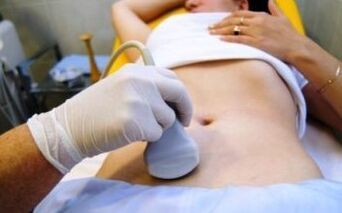The varicose veins of the pelvis (WRMW) or chronic pelvic pain syndrome remain an exotic disease with diffuse diagnostic limits for many doctors.
This explains the fact that some doctors "do not notice" this ailment for their patients for a long time, while others make this diagnosis to almost every second person suffering from constant inexplicable pain in the lower part of the abdomen.

Meanwhile, the quality of the patient's life, her ability to enjoy the intimate side of relationships with a loved one and the ability to continue her family, depends largely on the timely detection of varicose veins, depends largely.
Description of the disease, its prevalence, statistical data
The phenomenon of chronic pelvic pain has been known by doctors for a long time. But only recently became the rather known reason, the varicose veins of the pelvis. This is a diseaseIt was first described in 1975And still as well studied well.
It is more likely that this pathology will develop according to the following algorithm:
- The venous plexus in the pelvis is a complex formation, which includes both large vascular trunks and the smallest veins that extend from them. At the same time, the venous system of small pelvis in men and women differs in its structure, which determines the sexual specification of the disease - VRVMTIt is much more common in the weakest sex representatives..
- Due to the tight vessels, the complete or partial obstruction of the venous channel, the changes in the tone of the vascular walls are altered by the exit of the blood from the deep pelvic veins.
- As a result, the veins stop fulfilling their functions in its entirety:Progress the deficiency of venous valvesAnd a normal blood exit is altered.
- In the pelvic veins, the stagnant phenomena associated with the reverse blood thrown through the vessels begin: this causes the expansion of the veins and the development of varicose veins.

The symptoms of the varicose (varicose) veins of the veins of the internal organs of the pelvis are much more common in women of reproductive age than in men. At the same time, ovarial veins ("ovary") most frequently suffer, in 85% of cases.
The main symptom is the pain that is recorded in more than 90% of patients.. But the prevalence of this disease among the population has not yet been clarified: according to different studies, it is 6 to 80%. Such a great career in the "testimony" is explained only by the insufficient qualifications of diagnostic doctors when making a diagnosis.
Causes and Risk Factors
The causes of pelvic varicose veins are any change in the body that can cause the launch of the pathological mechanism of this disease:
- Inguinal hernia
- Tumor in the pelvis
- Increased pressure in abdominal cavity due to constipation
- Pregnancy and childbirth
- Gynecological diseases (uterine curve, ovarian cysts)
- Connective tissue diseases, particularly its dysplasia
- Stagnant phenomena in the glasses of the pelvis associated with lower sexual life
- Hereditary predisposition and congenital weakness of venous walls
- Long -term use of oral contraceptives
- Thrombosis propensity
The high risk factors VRVMT are:
- tense physical work;
- insufficiently regular or unsatisfactory sex life;
- abuse in intimate life due to interrupted sexual relations;
- a lot of pregnancies and childbirth;
- frequent gynecological diseases;
- contraception with hormonal drugs;
- hormonal malfunction in the body;
- Hypodinamia
Classification and stages of varicose veins
In the medical environment, the conditional separation of VRVMT is accepted by the nature of the course in varicose veins of the crotch and the external genitals (for example, lips) and venous plethora syndrome.
This classification is not very important, sinceIn most cases, patients have both formsAt the same time, such as provoking.
You can also find a classification of the disease due to the root cause of its appearance. In this sense, VRVMT is divided into:
- Primary- caused by the unsatisfactory work of venous valves;
- secondary- It develops as a complication of inflammatory, gynecological or oncological diseases of the internal organs.

What is dangerous and if there will be consequences?
This type of vascular pathologyYou can't call a mortal disease. Discovered in time, lends itself well to medical correction. But the whole problem is that finding it is not so simple. The insufficient knowledge of the disease and the low awareness of most diagnostic doctors play a role in this.
It turns out that patients have suffered this ailment for years without even suspecting it. And in your body, meanwhileThere are a number of irreversible changes:
- Varicosis progresses, adjacent areas are included in the pathological process: the expansion of the veins of the reproductive organs (for example, the varicose veins of the penis), the perineum and the lower extremities appear.
- Persistent dysfunction of internal genital organs appears, whichcan cause infertility or the inability to withstand pregnancyIn women.
- In the context of pain syndrome, several psychomotional disorders are developed due to the type of neurania.
- Due to chronic, aggravating pain during intimacy, a person can completely abandon sex.
- The rarest and at the same time complications of the pelvic varicose veins are considered thrombosis of the veins and thromboembolism of the lungs. TheyGather in approximately 5% of cases, but always mortal.
Diagnosis
According to US researchers, in the early 2000s, only 2% of patients with VRVMT initially made the correct diagnosis. Sometimes, a consequence of a diagnostic error was the elimination of detergent organs in women, although this could be avoided if they were usedThe most precise methods to diagnose pelvic varicose veins:
- Ultrasound and Dopplerographic Study of Venas- It makes it possible to suspect the varicose veins;
- Phlebography- Invasive study, which allows high precision to determine the presence and degree of disease;
- Laparacopia- In case of VRVMT differential diagnosis of the differential diagnosis of symptoms of gynecological diseases (endometriosis, myoma, colpitis).
- Selective ovaryography- The study of the state of the veins when introducing a subject of contrast is considered the most objective diagnostic method.
- Computer or Magnetic Resonance ImagesIt allows you to clarify the details of the disease course and differentiate it from other similar non -hydroxological pathologies in symptoms (joint diseases, Crohn's disease, etc. ).

Forecasts and preventive measures
It is almost impossible to completely cure the varicose veins of small pelvis without surgical intervention. With the help of conservative medicineIt can facilitate and even eliminate the most unpleasant symptoms.And significantly reduce the risk of disease complications. The operation does not give a hundred percent guarantee that the disease will not return.
To prevent a relapse of the diseaseIt is always necessary to adhere to a "anti -variable" lifestyle:
- No smoking;
- Do not use hormonal medications without control;
- move more and stand on your still feet;
- Observe an anti -clerotic diet with a large amount of fresh plant foods;
- Daily performs a complex of therapeutic exercises of gymnastics and breathing to maintain the health of blood vessels;
- After a surgical operation for VRVMT, it is necessary to wear compression knit garments and take preventive doses of venotonic medications prescribed by the doctor.
Pelvic varicose veins -This is a hidden flagella of women's health, a kind of ghost disease, which is difficult to find, but suffering is quite real.
The main symptom of the disease is a chronic pelvic pain that can torment the patient for a long time and become a source of abandoning many joys of life. You can't stand such discomfort and you can't see a doctor!
When specific symptoms appear, it must clearly understand that it is abnormal and immediately seek help from a specialist.

Basic therapy
In an issue like the treatment of the varicose veins of the pelvis, the base consists in the correction of its nutrition. To begin with, women with VRVMT must learn that even Detail will not have the efficiency of due if they do not refuse to work in harmful production.
If there is such an opportunity, it is better to change to a lighter job, excluding excessive physical activity, weightlifting.
If during a workday you have to sit or rest for a long period, organize an arrangement to break 5 minutes every half hour. At this time, you can walk or go to bed, or you can do therapeutic gymnastics.
High quality treatment of varicose veins is also not possible without changes in the diet. From the diet it is necessary to completely eliminate fat and fried foods, smoked food and conservation. Use the least amount of citrus fruits as possible, try to use condiments less frequently when cooking.
Add more natural products to your daily menu: fruits and vegetables. Instead of animal fats, use vegetables: they contain a large number of V vitamins E.
With the painful expansion of the veins of the pelvis, it is necessary to use special compression linen. We are talking about socks or socks that contribute to the normalization of blood circulation in the vessels, and also eliminate the stagnation of the fluid in the veins.
In addition to all of the above, women with VRVMT must participate in anti -varicosis methodology every day. Includes the following exercises:
- swim in the pool or open with clean water;
- jog in the morning;
- bicycle skiing;
- Assemble or skate.
A daily shower will help tone the veins. I water the hips, the abdomen and the buttocks with jets of different temperatures.
Drug therapy
If the disease of the pelvic veins is found in the initial development stages, you can try to deal with it with the help of medicines. The degree of damage can be detected by ultrasound (ultrasound examination of the pelvis veins).
Very often, there are the varicose veins of the pelvis during pregnancy. If a woman gives birth soon, it is necessary to stabilize her condition as soon as possible.
Preventive measures
Get rid of the varicose veins of the pelvis, without resorting to surgical intervention is almost unrealistic. However, ships never expand in their own, which means that problems can be avoided by adjusting their lifestyle.
Even after surgical intervention, it will not obtain an absolute guarantee that the ailment will not return again. Of course, modern conservative methods greatly simplify the treatment and recovery process. You can avoid relapse only if you follow a series of rules:
- Reject smoking;
- The cause of the varicose veins of the pelvis in women is often taking hormonal contraceptives that are incorrectly selected;
- Try to be physically active, take frequent breaks at work;
- Observe a diet for the varicose of a small pelvis: consume many natural foods of plant origin;
- Keep the glasses in the tone, performing therapeutic exercises for the varicose veins of the pelvis, as well as establish respiratory gymnastics;
- Follow all the doctor's recipes in the recovery period after surgical intervention: wear of compression underwear, take the medications on time.

Popular remedies
To relieve symptoms and accelerate the restoration of affected veins, it means the use of traditional medicine. However, do not use natural medicines without prior consistency with the doctor.
Effective Recipes List:
- The ground ginger (4 tablespoons) and the lemon zest are poured with boiling water (1 L). After cooling, honey is added to the infusion (2-3 tablespoons of L. ). The drink is used instead of tea.
- The chestnut of the horses (200 g) is crushed and poured with vodka (1 l). The tool is infused for 7 days in a dark place. Recommended dose: 10 drops 3-4 times a day for a month.
- The oak, sauce and brown branches in a crushed form (1 tablespoon) are poured into a pan, are poured with boiling water (1 L) and are placed on low heat. Half an hour after boiling, the decoction is removed from the stove and cools. Then, chamomile, series, drying and grass of San Juan (1 tablespoon) are added. The deadline is 12 hours. A little honey must be put on the filtered drug.
The decoction scheme: the first 2 days - 3 times 50 ml, the next 2 days - 100 ml, in the future, the dose increases to 150 ml. The duration of the therapy is 20 days, after which a break is performed for 10 days.
To improve the condition of blood vessels, it is useful to use blueberries, as well as flower pollen daily.
By using popular remedies, it is important to understand that they only complement the main dish, so it is not desirable to reject the medications prescribed by a doctor.
The regular medical examination is not of little importance, which will allow you to detect any deviation over time and proceed to therapy. The sooner the disease is detected, the easier it will be to deal with it. Severe cases require prolonged treatment.
Varicose lesions of the veins of the pelvis without pronounced symptoms can be eliminated by conservative methods. They fight with a careless illness with the help of surgery, even after surgical manipulations, a repeated occurrence of pathology is possible.
It will be possible to minimize the risk of VRVMT thanks to prevention, which implies a healthy lifestyle.

















